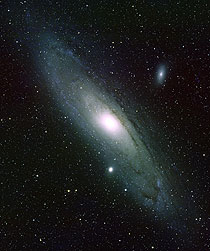January 8, 2007
Astronomers discover an enormous halo of red giant stars around Andromeda
By
Tim Stephens
Astronomers have found an enormous halo of stars bound to the Andromeda galaxy and extending far beyond the swirling disk seen in images of the famous galaxy, our nearest large galactic neighbor.

The newly discovered stellar halo of the Andromeda galaxy extends far beyond the disk and central bulge seen in this image.
Photo: Bill Schoening, Vanessa Harvey/REU program/NOAO/AURA/NSF |
The discovery, reported this week at the American Astronomical Society meeting in Seattle, suggests that Andromeda is as much as five times larger than astronomers had previously thought.
"I am absolutely astounded by how big this halo is. As we looked farther and farther out, we kept finding stars that look like halo stars," said Puragra (Raja) Guhathakurta, professor of astronomy and astrophysics at UCSC, who is presenting the findings at the meeting.
Guhathakurta and his collaborators at UCSC, UCLA, and the University of Virginia are conducting an ongoing study of Andromeda's stellar halo, using observations at the Kitt Peak National Observatory in Arizona and the W. M. Keck Observatory in Hawaii. Their new findings are based on data gathered using the 4-meter Mayall Telescope at Kitt Peak and the DEIMOS spectrograph on the 10-meter Keck II Telescope in Hawaii.
The researchers detected a sparse population of red giant stars--bright, bloated stars in a late stage of stellar evolution--that appear to be smoothly distributed around the galaxy out to a distance of at least 500,000 light-years from the center. Even at that great distance, the stars are bound to the galaxy by gravity. These stars probably represent Andromeda's stellar halo, a distinct structural component of the galaxy that has eluded astronomers for over 20 years, Guhathakurta said.
Following up on their discovery of Andromeda's halo, the researchers have found evidence that stars in the halo are chemically anemic compared with stars in the inner parts of the galaxy, said Jasonjot Kalirai, a postdoctoral fellow at UCSC. The halo stars are "metal-poor," meaning they contain smaller amounts of the heavier elements, a finding that is consistent with theoretical models of galaxy formation, Kalirai said.
Andromeda (also known as M31) is a large spiral galaxy very similar to our own Milky Way. While it is difficult for astronomers to study the overall structure of the Milky Way from Earth's vantage point within it, Andromeda offers a global view of a classic spiral galaxy that is close enough for astronomers to observe individual stars within it. Andromeda is about 2.5 million light-years from Earth and is the largest galaxy in the "Local Group," which also includes the Milky Way and about 30 smaller galaxies.
"The physical size of this galaxy is really striking," said coauthor R. Michael Rich of UCLA. "The suburbs of M31 and the Milky Way are so extended that they nearly overlap in space, despite the great distance between these two galaxies. If the whole of M31 were bright enough to be visible to the naked eye, it would appear to be huge, larger in apparent size than the Big Dipper."
Spiral galaxies typically have three main components: a flattened disk, a bright central bulge with a dense concentration of stars, and an extended spherical halo of sparsely distributed stars. The concentration of stars in the central bulge decreases exponentially with increasing distance from the center, whereas the density of the halo stars falls off more gradually (as an inverse power of the radius).
In Andromeda, the disk has a radius of about 100,000 light-years. Outside the plane of the disk, stars plausibly belonging to the central bulge can be found as far out as 100,000 light-years from the center of the galaxy, while the halo extends five times farther than that, according to Guhathakurta.
"We now believe that previous groups have been mistakenly identifying the outer parts of the Andromeda bulge as its halo," he said.
Guhathakurta's group was able to detect the halo by developing a sophisticated technique for clearly distinguishing halo stars in Andromeda from the more numerous foreground stars in the Milky Way. A foreground star with low luminosity and a luminous star that is much farther away can be hard to tell apart because they appear to be equally bright from our perspective, Guhathakurta said.
"A firefly 10 feet away and a powerful beacon in the distance can have the same apparent brightness. In this case, the fireflies are dwarf stars in our own galaxy and the beacons are red giant stars in Andromeda," he said.
Karoline Gilbert, a UCSC graduate student, developed the technique for separating the fireflies from the beacons. Her technique provided a clear separation between the two populations of stars by combining five diagnostic criteria based on photometry (brightness measurements) and spectroscopy (which separates starlight into a spectrum of different wavelengths). The diagnostic criteria include radial velocity and parameters based on differences in surface gravity between red giants and dwarf stars.
"We focused on detecting red giant stars in the halo because they are bright enough for us to obtain spectra," Gilbert said. "There are assuredly other kinds of stars in Andromeda's halo, but they are just too faint for us to get spectra of them."
In addition to Gilbert, Guhathakurta, Kalirai, and Rich, the other collaborators include Steven Majewski, James Ostheimer, and Richard Patterson at the University of Virginia and David Reitzel at UCLA.
The group's ongoing investigation of Andromeda's halo promises to shed new light on the question of how large galaxies formed, Guhathakurta said.
"Galaxy formation theories tell us that halos are pristine--the oldest component of the galaxy--but this is based almost entirely on studies of our own galaxy. A detailed study of this newly discovered Andromeda halo will allow us to test whether these theories apply more generally to galaxies other than the Milky Way," he said.